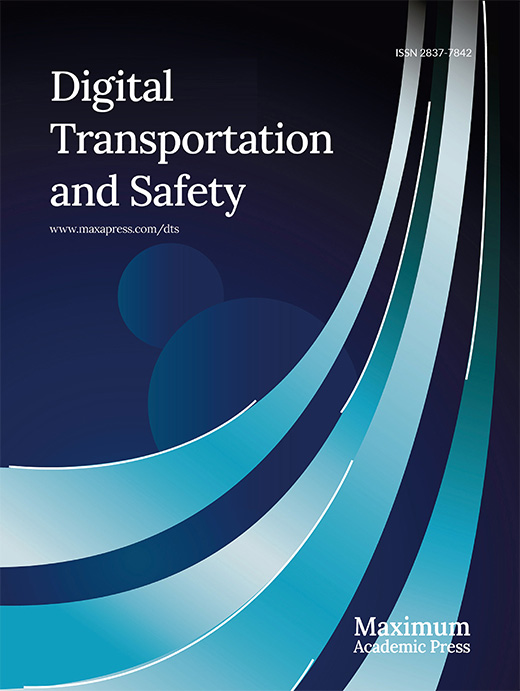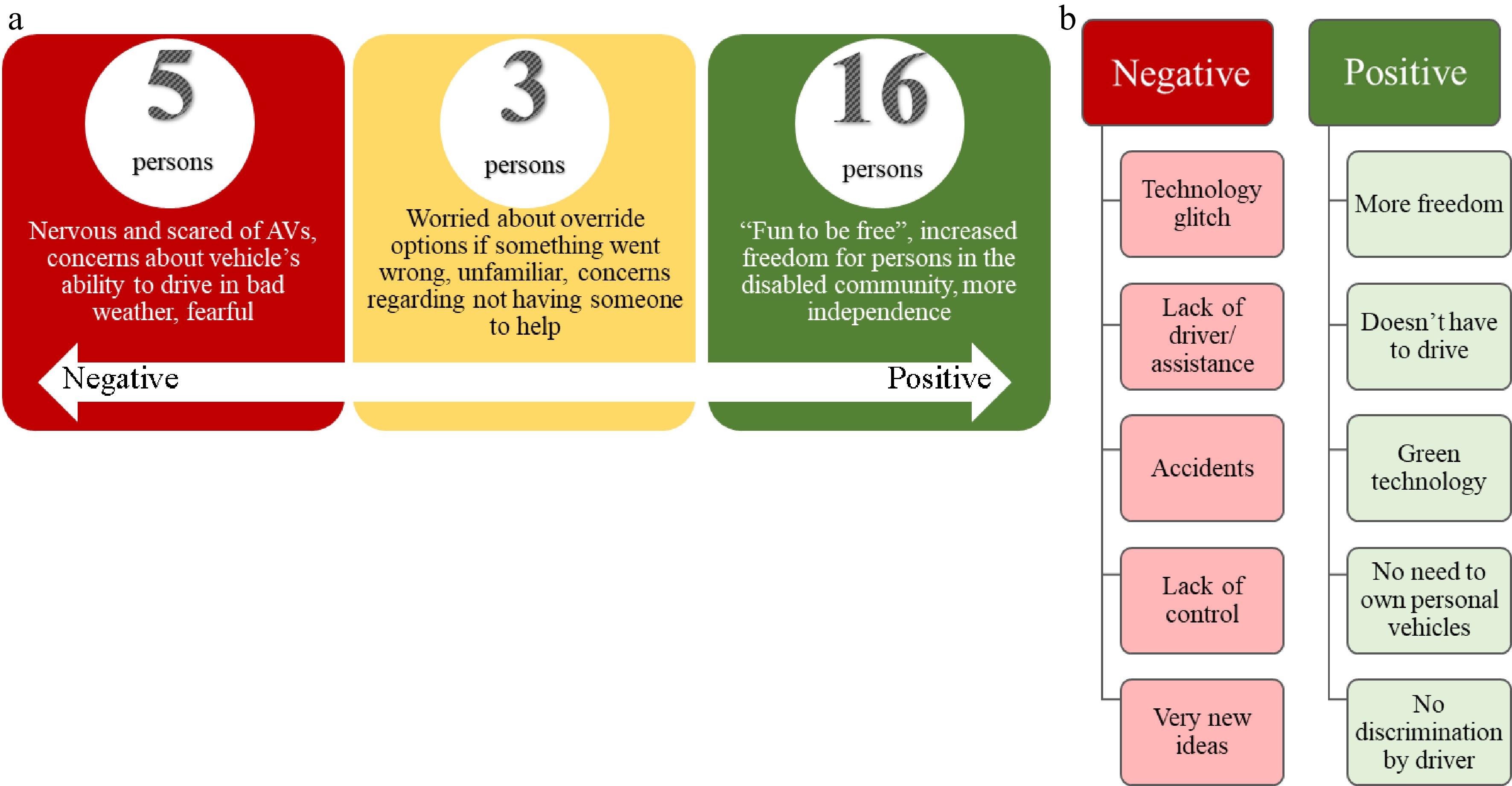-
In the United States, there are over 64 million persons with disabilities (PwD)[1] and up to 85% of PwD rely on public transportation or someone else for a ride[2,3]. In the state of Michigan (USA), one in four adults has a disability[1]. The percentage of PwD who rely on public transport is significantly higher compared to the reliance on public transportation of the general public[3,4]. Despite this reliance on public transportation, studies have shown both access to, and accessibility to transportation is lacking for persons with reduced mobility[5−8]. More specifically, due to the lack of accessibility 30% of PwD struggled with access to transportation compared to 10% of the able-bodied population[6,9].
The lack of accessible transportation for PwD has caused significant issues in their everyday lives[3,10]. They reported transportation inaccessibility hinders their social interactions and subsequent healthy social lives[2,3,10−13]. Common issues with accessible transportation included confining hours of operations, which often excluded holidays, fixed route systems[2,14], and the requirement of advanced scheduling of rides[6,7,10,14]. Limited social interactions related to the lack of accessible transportation have been reported to lead to feelings of isolation especially for individuals who have a disability[15]. Further, there existed a relationship between measures of individuals' health and their social participation[12,15]. PwD reported that a lack of accessible transportation also acted as a barrier for access to employment[3,16−18]. In addition to less social participation and increased isolation, many people missed necessary medical appointments due to a lack of transportation[2,10,11]. Thus, this lack of transportation has led to increased dependence, reduced physical and emotional health, a decrease in social interactions, and an inability to travel spontaneously.
Research has shown that PwD view autonomous vehicles (AVs) as a promising mode of transportation[11,19−21]. While PwD have voiced concerns and anxiety regarding the safety and accessibility of AVs[4,5,19−23], the literature suggests there were strong positive outlooks on the potential to increase independence and travel rates[11,20−22,24]. More specific concerns stemmed from fears of technological issues[4,19,21], mechanical issues[22], a lack of human interaction[4,21], and a lack of familiarity with AVs[5,22]. For PwD to feel more comfortable using AVs as a form of transportation, not only must the designs of the vehicles consider their concerns and needs, but also consider the location and physical environment for the pick-up and drop-off (PUDO) zone.
The majority of the published research has focused on the opinions, perceptions, and challenges associated with AVs as a mode of transportation for PwD[5,11,19,20]. Some studies utilized survey methods to reach a large number of participants[2−4,6,10,11,19−21], while other studies utilized focus groups or interviews to gather more specific data with smaller sample sizes[5,12]. A few studies touched on the infrastructure as a reason for inaccessibility and noted it was an avenue for improvement[14,22,25,26]. However, there was a lack of information regarding the issues related to this claim, particularly with respect to the specific PUDO zones and access of the PUDO zone[27]. Both the location and the design of the PUDO zone as well as appropriate infrastructure to travel to the PUDO zone were important for accessibility[14,22]. When considering the use of AVs, PUDO zone identification became even more critical as this would be pre-determined by the vehicle and the navigation system.
Thus, the goals of this study were to identify the challenges for persons with disabilities with current PUDO zones, identify future PUDO needs for on-demand vehicles and autonomous vehicles, as well as quantify their comfort level with these vehicles.
-
Approval for this study was granted under the University's Institutional Review Board (#00008015). All participants were provided with a full consent process, and consent was obtained before participating in the interview.
Participant eligibility and recruitment
-
Inclusion criteria required that individuals were over the age of 18 and had a self-reported mobility or visual disability that required the use of a mobility aid (i.e., wheelchair, walker, cane, crutch, scooter, etc.). Participants were recruited through the use of flyers placed throughout the greater Lansing area, emails to different disability networks and church groups, and through local adaptive sports groups. Recruitment of participants and the in-depth interviews occurred between 2022 and 2023. To increase the accessibility of the study, participants were given the option of an in-person or virtual interview. Virtual interviews consisted of Zoom (Zoom Video Communications, San Jose, CA, USA) and telephone interviews. If a participant chose the in-person option, written consent was obtained. If a participant chose the virtual interview option, verbal consent was obtained. Twenty-five individuals participated in the study and each received compensation of USD
${\$} $ Interview structure
-
This study was descriptive. The interview contained 33 structured questions. The interview questions were reviewed and piloted with several individuals who either had disabilities or worked in the area of disabilities before distribution of the final interviews. There was an assortment of questions including open-ended and multiple-choice style questions. The questions covered a variety of topics: demographics (six questions), personal travel patterns (ten questions), loading/unloading of a vehicle PUDO zone (seven questions), ideal AV experiences (two questions), vehicle configuration (five questions), vehicle identification (two questions), and technological barriers (one question). Samples of questions from each topic section are shown below.
(1) Demographics: What are your disability(ies)? What body regions are affected by your disability(ies)?
(2) Personal Travel Patterns:
a. What is considered bad weather for you to travel in? Why?
b. What is your current comfort level with traveling alone? (e.g., very comfortable to very uncomfortable)
(3) Loading/Unloading of a Vehicle PUDO Zone:
a. Is a curb cutout necessary for your loading/unloading?
b. Would you rather be picked up/dropped off close to a door where you may have to go over a curb or in a nearby alley further away but not have to navigate over a curb?
(4) Ideal AV Experience: Are you excited about any aspects of Autonomous Vehicles (AVs)? If not, why? What are your initial concerns?
(5) Vehicle Configuration: How does the vehicle configuration affect your ability to load/unload into the vehicle? Ex: location of doors, multiple doors, type of doors, internal set up of vehicle.
(6) Vehicle Identification: How would you want to identify a vehicle you hailed (e.g., an 'Uber-like vehicle')? Meaning, what would you like to see/hear/touch on the outside or top of the vehicle and why would that be useful?
(7) Technological Barriers: Do you currently face any technological barriers to access public transportation that could make it hard to use an app? Ex: Internet access, smartphone access, credit card access, etc.
Each question was verbally read to the participants and their verbal answers were typed out by a study administrator during the interview. Participants were given the opportunity to provide any extra information they deemed pertinent to the study after the completion of the structured questions. All interview data were de-identified and stored with a participant identifier after the conclusion of the interview to protect confidentiality of participant responses. The interview data were recorded in Word (Microsoft, Redmond, WA, USA) and then organized into a spreadsheet using Excel (Microsoft, Redmond, WA, USA), where responses were sorted and analyzed based on each of the seven topical sections.
-
The age range of participants was 21−74 years with an average age of 43 years (16 years standard deviation). For further analysis, participant age was broken up into three categories: under 35 (nine participants), 35 to 50 (seven participants) and over 50 (nine participants) years. A variety of devices were utilized by participants and some used more than one type of device. These included motorized wheelchairs, manual wheelchairs, and walker/cane/crutches (walking aid). The types of assistive devices used were manual wheelchairs (52%), motorized wheelchairs (20%), walking aids (24%), and other devices (4%) (Fig. 1a). The self-reported gender identity distribution of participants was 18 males and seven females. The most prevalent disabilities included cerebral palsy (n = 8) and spinal cord injuries (n = 9), which included both para and quadriplegics. Additional impairments in the sample included visual, traumatic brain injury, stroke, arthritis, hip replacement complications, and other genetic disorders. Some participants reported multiple disabilities. Three participants also had visual impairments. The visual impairments of two participants were related to their mobility disability, but visual impairments were not the focus of this study.
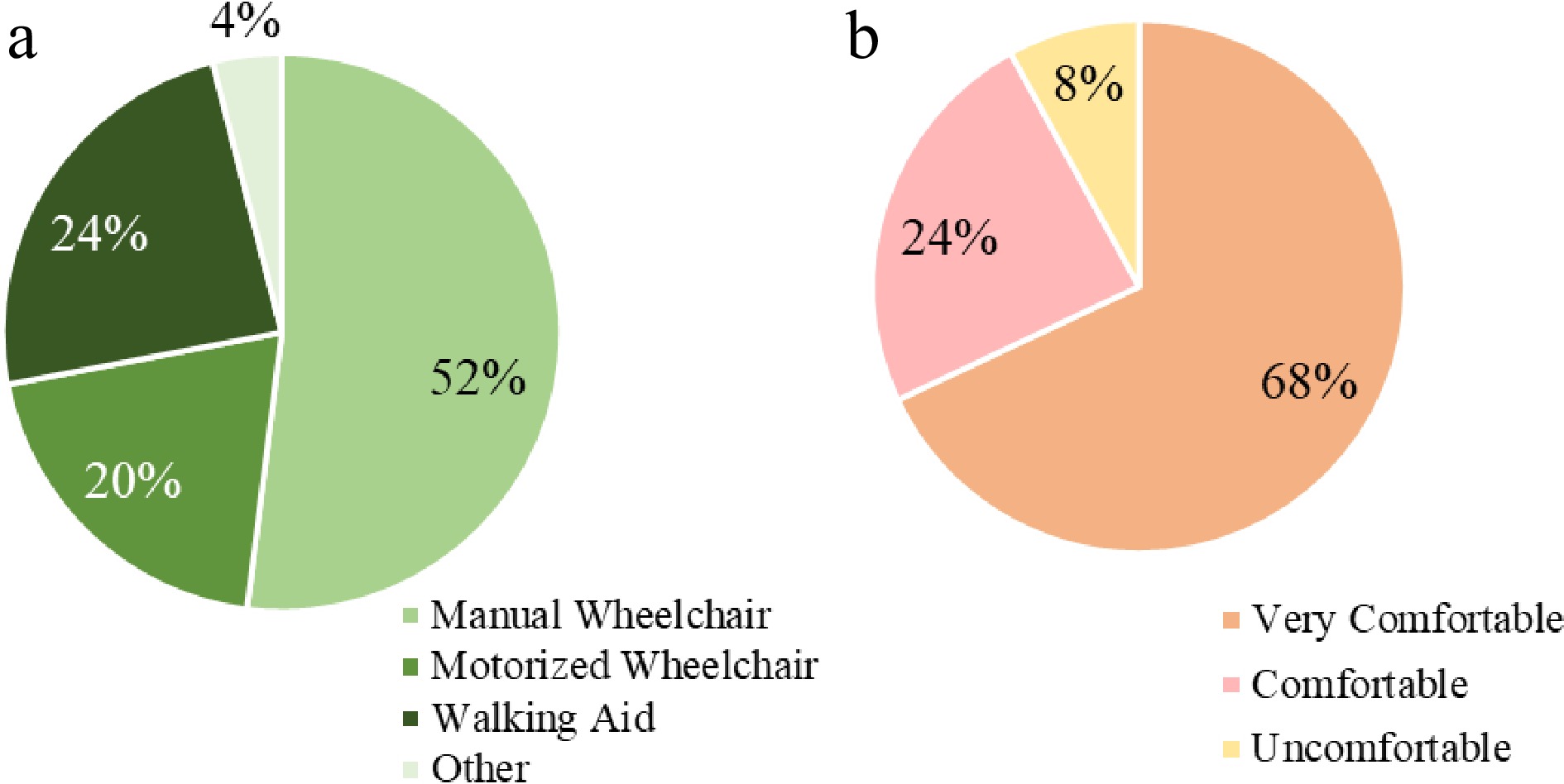
Figure 1.
(a) Percent of mobility devices most prevalently utilized by 24 participants (one participant had a visual disability and did not utilize an assistive device). (b) Comfort level of participants traveling alone in their everyday lives.
Most of the participants indicated they drove themselves (n = 16); paratransit was the second most used mode of transportation (n = 6). Other forms of transportation mentioned: being driven by friends or family (four participants) and the bus system or Uber (two participants).
Participants were asked to rank their level of comfort with traveling alone (range of very uncomfortable to very comfortable). Overall, 17 participants were very comfortable traveling alone. However, manual wheelchair users were the largest percentage of participants who were very comfortable alone (69.2%) when compared with the other device users (Fig. 1b). Sixty-eight percent of participants were very comfortable traveling alone, and at least 90% of participants were comfortable or very comfortable traveling alone. Eighty-three percent of individuals in the age range of under 35, 93% in the 35-to-50-year age range, and 83% in the over 50-year age range are comfortable or very comfortable traveling alone.
Challenges
-
Participants were asked to share challenges they faced with their current modes of transportation. Of the participants who utilized paratransit, two-thirds mentioned that scheduling and timing of rides was problematic. One-third said the lack of a 'quick trip' due to scheduling of rides caused inaccessibility and difficulty with running errands. For the participants who were driven or drove themselves, 33.3% mentioned that transferring into their vehicle, manual loading of their device, or getting into their vehicle while staying in their mobility device was difficult. This included vehicles that may have been too high, too low, hard to transfer into, or blocked by snow. Two participants who utilized on-demand car services mentioned problems with the lack of accessibility of the vehicles and the service. For example, one participant shared that they had an experience where taxis would not stop for them when they saw they used a mobility device.
This study investigated two primary options of entry and exit to a vehicle (ramp and lift). Participants were asked about their preference between a ramp and a lift and the rationale for their selection. For the set-up of these scenarios, the vehicle loading height was 14 inches off the ground and was based on an anticipated vehicle height of a larger electric vehicle. More participants preferred a ramp (nine participants) to lifts (six participants) or had no preference between ramps or lifts (six participants) (Fig. 2a). Four participants reported that they would not use a ramp or a lift to load into or unload from a vehicle. The most common reason for the ramp preference was that it was faster than using a lift. The most common negative opinions on ramps were that ramps could be too steep or narrow. Positive views on lifts related to them being more spacious than a ramp, which led to fewer feelings of confinement or worries about the accuracy needed for the loading zone (i.e., not going off the side). Common negative views of lifts were concerns related to breakdowns, and that they can be slow and awkward to use. Additionally, some participants mentioned experiences they had where a lift stalled or was slow-moving in poor weather and they were not in control of the situation – thus, getting rained or snowed on.
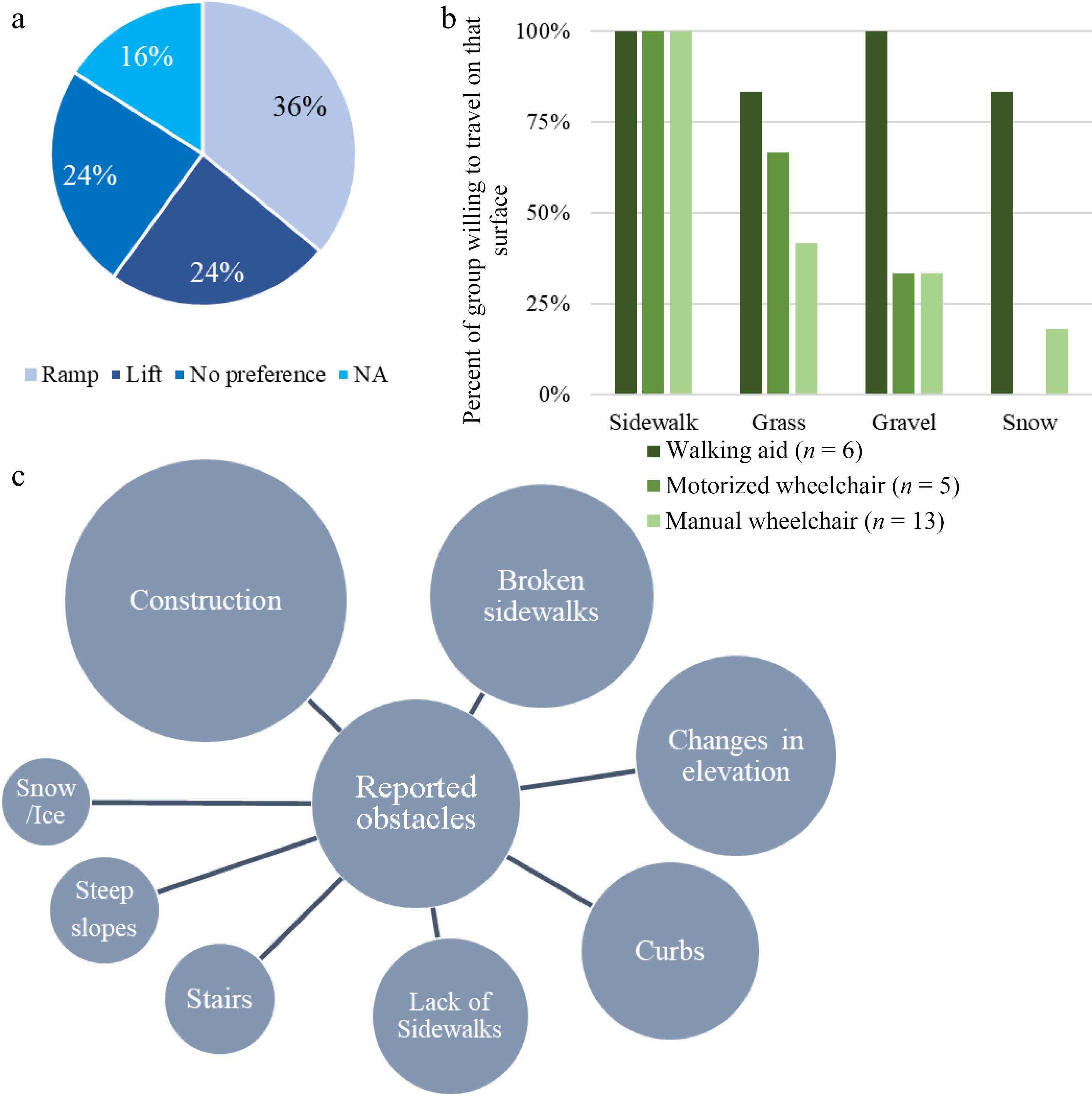
Figure 2.
(a) Participant preference for a ramp or a lift. NA accounts for PwD who did not rely on a ramp or a lift. (b) Percent of participants, based on mobility device used, and willingness to travel on four different surfaces. (c) Obstacles reported by participants sorted by the most commonly reported that would limit access to a PUDO zone. (The larger the circle, the more reports associated with this challenge).
A lack of curb cutouts is a barrier for PwD who are unable to navigate over curbs. Participants were asked if they needed a curb cut when navigating to PUDO zones. Half of the older participants (> 50 years old) said they needed a curb cut, but only 13% of the under 35-year-old population said they needed a curb cut. When looking specifically at the device used, over 70% of motorized wheelchair users needed a curb cut out while no participants who utilized a walking aid identified the need for one. When asked what they deemed to be bad weather, 100% of participants noted snow, 40% of participants mentioned rain, and 32% said extreme temperatures.
When asked about which surfaces participants would be comfortable traveling on using their respective device, all device users were comfortable traveling on a sidewalk, as long as there were no obstacles or uneven ground (Fig. 2b). Walking aid users were more comfortable on all surfaces (grass, gravel, and snow) when compared to motorized or manual wheelchair users. Wheelchair users had experiences where they traveled onto some grass, gravel, or snow and their tires sunk into the ground sometimes requiring assistance from others to help get them unstuck. Over half (64%) of participants reported elevation changes (steep sidewalks or cross slopes) as obstacles that could prevent access to a PUDO zone (Fig. 2c). Other obstacles that could prevent PUDO zone access included construction on the sidewalk or nearby road (52%), broken sidewalks (mis-match or not smooth also included) (40%), and various road conditions (40%) including ice, potholes or cracks. A quote from a participant regarding inaccessibility that resulted from construction: 'construction is unpredictable and can cause confusion'. Broken sidewalks 'have the potential to puncture a tire' on their wheelchair, said another participant.
For PwD the unknown can be challenging. Going off the planned route or to a new area was noted to be difficult, leading to participants' discouragement, frustration, or abandonment of accessing the desired location. Participants reported challenges they faced in city and rural areas. A major challenge that arose in city areas were sidewalks that were not in good condition, which included potholes, construction, or uneven/broken sidewalks. Additionally, heavy foot traffic and unobservant pedestrians, a lack of curb cuts, on-demand vehicles not being accessible or not stopping to pick them up, and double-parked vehicles near PUDO zones were challenges in city areas. Similar challenges were reported in rural settings including lack of on-demand vehicles (Ubers or taxis), lack of curb cuts, rough ground, confining hours of operation of paratransit, and lack of sidewalks.
PUDO location
-
Participants were also asked to share some of their personal experiences and needs of existing PUDO zones. Participants open-endedly responded to this question. Important aspects regarding safety included a well-lit area and to be able to properly see to load and unload (35%), as well as a designated place to wait, like a covered bus stop (17%). Other important safety considerations were a spot for the vehicle to pull out of vehicle traffic that was also away from main foot traffic for loading and unloading. Additionally, an emergency call button was also an important safety consideration.
When asked about waiting for a vehicle, 21 out of 25 participants indicated that they would prefer there to be an option for them to wait inside a building for the vehicle to arrive. Thirteen out of 25 stated that their decision depended on the weather. On nice weather days they would wait outside, and on bad weather days they would like the option to be inside.
In total, 10 participants preferred to be dropped off closer to the door where they would have to navigate over a curb rather than have a farther distance to their destination (Fig. 3a). There was a difference in the desired drop-off location among the different age groups. For the over 50 participants, eight out of nine preferred to be dropped off farther away where they would not have to navigate over the curb, but for the under 35 participants, only three out of eight preferred the farther away drop off location. Four out of six participants who utilized a walking aid said they would prefer the close drop-off option in comparison, only one out of four motorized wheelchair users would choose the close option (Fig. 3b).
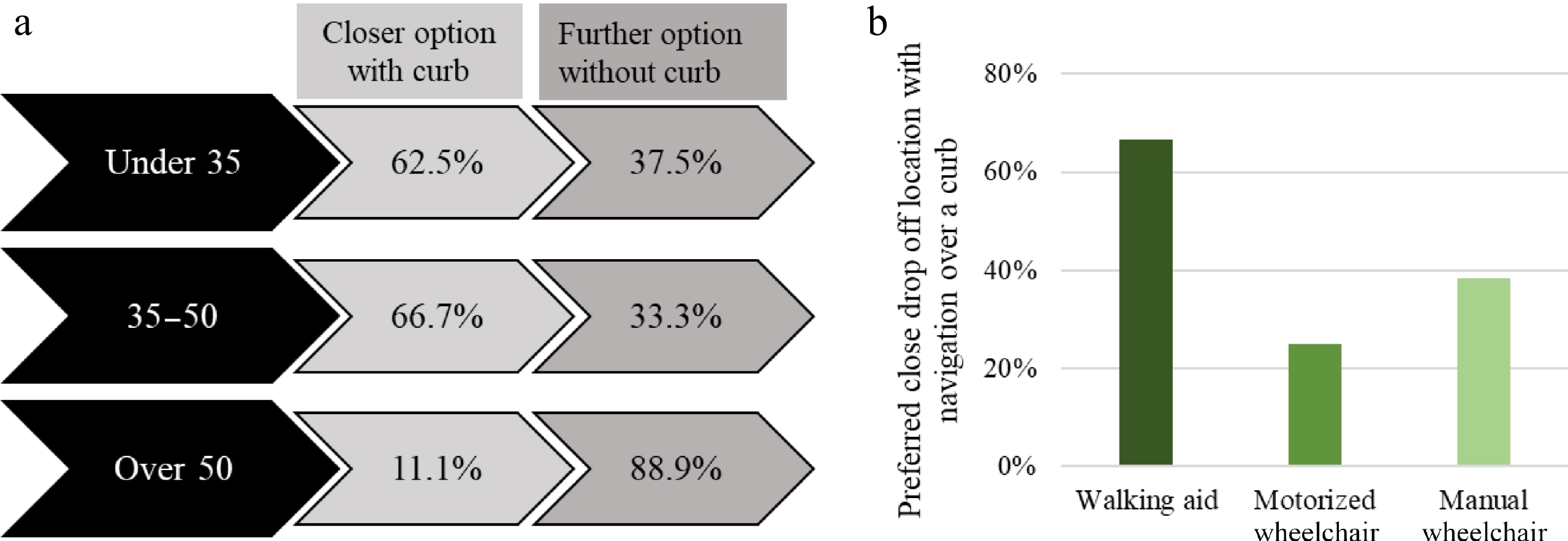
Figure 3.
(a) Distribution of drop off location preference broken up based on age. The close drop off location would require the participant to navigate over a curb from a stop near their final destination, and the alley drop off location would not have the curb but would be farther from the final destination. (b) Percentage of participants, based on their main assistive device used, who preferred the closer option when asked: 'Would you rather be picked up/dropped off close to a door where you may have to go over a curb or in a nearby alley that is further away but you would not have to navigate over a curb'?
New technology
-
In addition to the accessibility of AVs, the perceptions and interest in AVs are also important. The majority (n = 16) of participants had positive views on AVs, while three had neutral views and five had negative views. Thirteen out of 18 men had positive views on AVs while three out of seven women had positive views on AVs. The most prevalent reasons for positive views on AVs were greater independence and not having to drive oneself (Fig. 4b). A quote from a participant said, 'It can be fun to be free'. The most prevalent reasons for negative views on AVs were possible technological glitches and the lack of a driver or assistance from a driver.
When asked about technological barriers to using a phone to request/hire the AV service, 80% of participants reported having no barriers to sending and receiving text messages and use of apps. Barriers could include not having a cell phone, lack of cell service or the inability to use a cell phone due to problems with finger dexterity. For the over-50 population, 44% of the participants reported having barriers to accessing technology which was much higher than the under-35 group where none of the participants reported barriers to accessing technology (Fig. 5).
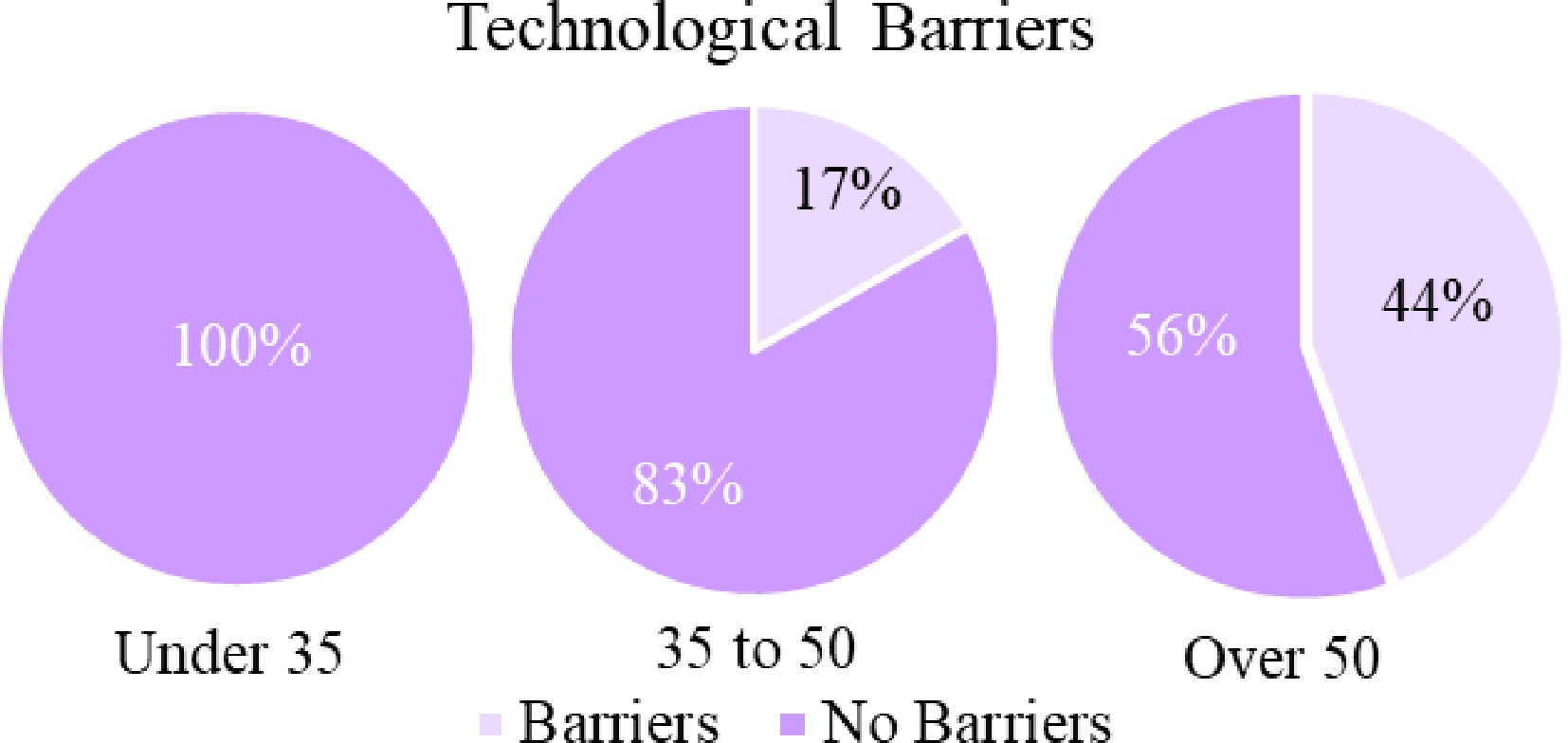
Figure 5.
Distribution of technological barriers (such as cell phone and app usage or sending and receiving text messages broken up based on age).
Participants were asked about their vehicle configuration preferences, eight out of 25 participants (all eight were wheelchair users) reported the need for space to turn around or move throughout the vehicle, seven (five wheelchair users, two walking aid users) wanted doors that were large and swung open wide, three (all wheelchair users) chose sliding doors over the wide swinging doors. For loading into the vehicle, eight (seven wheelchair users, and one walking aid user) preferred side loading into the vehicle over rear loading.
Participants were asked what would be necessary or beneficial to help identify the vehicle. Five participants asked to be informed about the make/model/color of the vehicle. Other beneficial elements for identification of the vehicle included an audio cue once the vehicle has arrived, the logo of the vehicle company displayed on the vehicle, and knowing the live position of the vehicle is provided through an app to help them locate the vehicle.
-
The findings of this study provided critical information necessary for increasing accessibility to various types of transportation, especially when considering advancements in technology that will permit autonomous on-demand vehicles. Through detailed, in-depth interviews, it was found that age and mobility devices are factors that strongly influence the preferred location for pick up and drop off. Also, the type of system for ingress and egress to and from the vehicle – ramp or lift – each had challenges and advantages, with preference being based on prior experiences. On-demand AVs (like the Uber or lift model) have significant potential to increase the transportation accessibility of individuals with mobility devices. However, this will only occur if these types of vehicles can identify acceptable PUDO regions and meet the rider, or drop them off, at these locations.
Through in-depth interviews with individuals who used assistive mobility devices, many challenges, inaccessibility and needs for transportation were uncovered. One major current challenge for the interviewees was the confining scheduling and fixed route transportation systems. Limited schedules and fixed route systems caused them to miss out on important events such as doctors' appointments, social gatherings, and holidays with family and friends. The inability to call for a ride the same day was cited as a significant challenge for all transit users. The independence that accessible AVs bring to the community, particularly for those who have disabilities, would increase the spontaneity of their transportation resulting in increased opportunities for travel, social engagements, medical attention, and employment.
The PUDO loading/unloading choices (i.e., ramp and lift) of participants were heavily influenced by the participant's previous experiences, both positive and negative. Although ramps were preferred by the participants in this study, ramps in compliance with The Americans with Disabilities Act would require adequate space for deployment and could limit the PUDO locations for the vehicle and put users further from their vehicle/destination. Loading/unloading of the vehicle also caused inaccessibility and frustration for PwD. For example, participants shared experiences of ramps not being able to properly deploy and sit safely on the pavement or drivers of vehicles not knowing how to properly deploy or secure the ramp or a lift. Some participants shared concerns that they do not want their loading or unloading to interfere with the sidewalk traffic.
Curb cuts within the PUDO region were necessary for many PwD especially for older populations and those who utilize manual or motorized wheelchairs. Walking aid users were more likely to be able to navigate a curb without a curb cut, but to make the PUDO locations accessible for all, the wheelchair users' requirement of a curb cut needs to be addressed. Without a curb cut, PwD found themselves in inaccessible and sometimes dangerous situations when trying to access a PUDO location or their destination. A participant who utilized a wheelchair shared an incident where they had not been able to see the edge of the curb and went over the side of the curb and fell out of their chair. They then had to call for emergency services to have someone come to help them back into their wheelchair and safely off the street. Some participants also shared that they had been hit by cars when crossing a street. These incidents highlight the importance and critical need for safe access to the PUDO zone and safe loading/unloading in the zone.
Uncertainty of situations as well as weather were reported challenges that affected the preferred PUDO zones and loading/unloading processes. Participants shared that when snow was piled up onto curb cuts normally accessible situations became inaccessible and dangerous. Participants wanted to be picked up or dropped off as close to their destination as long as it was safe and accessible. Participants reported that familiarity with their environment was important and having to be dropped off away far from their destination could cause them to face unfamiliar situations. The 'uncertainty of what might happen' was a recurrent theme gathered from the interviews. In addition to weather, obstacles such as construction, broken sidewalks, elevation changes, cross slopes, and lack of curb cutouts also contributed to this uncertainty and the safety of the PUDO location.
-
The identification of the current challenges with PUDO zones for persons with disabilities is necessary to set the foundation for future work and the implementation of accessible AVs. Some of the challenges persons with disabilities faced were staying out of traffic, both foot traffic, and other vehicle traffic. Participants reported that they did not like to feel rushed and did not like to feel like they were in the way or burdening others. Participants liked the option of a nearby building to wait inside to stay out of the previously mentioned traffic and to be protected from weather; some reported their mobility device cannot get wet or may become damaged. If their device was to be damaged, whether by bad weather or mishandling by a driver, they may be isolated for long periods while their devices are repaired or replaced. Crosswalks, although useful, can be the source of stressful and sometimes unsafe situations for many mobility device users as they may feel rushed by vehicles and pedestrians. Hearing about the challenges facing PwD, from those most affected by inaccessibility, provides the foundation for identifying changes necessary for improvement to PUDO zones.
This work aimed to identify the current challenges of PwD to determine the future needs of PUDO zones so that they are fully accessible to a variety of device users. When designing and deciding on PUDO zones, it is important to consider the diversity of potential users. Diversity includes age, disability, type of assistive device, and whether the person needs additional assistance from another person. This study gathered data on ages 21 to 74 but with a growing elderly population, additional research is warranted with a focus on older populations to determine if there are age-specific needs. Further, focused work on specific disabilities or specific devices could be a future area of investigation. As technology advances, accessible vehicles could have the opportunity to select mobility options for users, who can then specify their mobility device and their personal accessibility needs such as the necessity of a curb cut out, or distance to their final location. A study utilizing in-person scenarios and questions could be a beneficial tool to help PwD visualize different PUDO loading situations and provide more in-depth responses to accessibility questions. This would further support PUDO accommodations and accessibility to their lifestyle.
Identification of challenges associated with mobility and PwD has wide-reaching applications. Current infrastructure can be adapted to be more accessible such as reducing wait times for rides, PUDO zones co-located near curb cutouts, and having considerations for weather such as snow, and act accordingly. One example of these challenges and attempts to increase accessibility can be seen in a resource around Metro Detroit. Is the metro accessible? is a website that allows for self-reported descriptions of PUDO locations describing the function and accessibility of each[28]. Such information informs potential users about accessibility issues. Incorporation of such a website with policy would also be beneficial. For example, if construction is being performed, a notification that a disruption to the sidewalk and areas surrounding a PUDO zone could be automatically distributed to all transportation entities. The Federal Transit Administration launched the All Stations Accessibility Program in 2024 which provided funding to create accessible rail stations across eight states[29]. Information from the present study could be used to help with the accessibility of these rail PUDO zones, but a program (or future policy) such as the All Stations Accessibility Program for other types of transportation including bus and ride sharing would be ideal for the implementation of AVs[29]. Future transportation changes that would benefit PwD would be vehicles that are more versatile in the timing, alleviating the need to schedule rides in advance and having large windows of pick-up times. The ability to have access to a vehicle that could be used for a quick trip, such as an appointment or to pick up a prescription would give independence and accessibility to people who rely on accessible transportation. The implementation of 'on-demand' rideshares or AVs that can support PwD would be a tremendous asset to supporting all community members.
The final goal of this study was to determine the comfort levels of PwD toward AVs. The findings show that PwD reported feeling excited about the benefits and independence that AVs could have on their lives. The positive views were consistent throughout varying ages and devices used by participants. One barrier for on-demand AVs was seen with the older than 50 population as they reported more challenges with technology and app usage. Despite there being some concerns regarding AVs, the overwhelmingly positive views on the ability for AVs to address current challenges shows the usefulness and the positive impact that AVs could have on the community. In conclusion, there many challenges are currently affecting access to transportation for PwD and knowledge of these challenges provide information that will help shape future PUDO designs, AVs as well as potential policies supporting these areas.
-
This is a convenience sample and the individuals who participated in this study self-reported their disability. There may have been some bias in the sample size, as the majority of participants were in the mid-Michigan location. Additionally, participants had to be willing to talk to and provide insights to the researchers about their challenges with regards to mobility. The majority of recruitment efforts were in a county with a middle-income household range[30]. The income range may also present a bias within our sample.
Portions of this work were presented as a poster by the first author on one occasion at our University, May 2023. Portions of this work were presented as a poster by the second author at two occasions at our University, and January 2023 and April 2023. We would like to thank the Michigan State University Adaptive Sports and Recreation Club for their participation in the research. We would also like to thank the other Ford employees who contributed to the project idea and discussions of the findings. This work was funded by Ford Motor Company.
-
The authors confirm contribution to the paper as follows: project administration: Kanat S, Guzak K, Bush TR; investigation, methodology: Kanat S, Harth R, Bush TR; data curation, writing – original draft, visualization: Kanat S, Harth R; writing - review & editing: Kanat S, Harth R, Guzak K, Bush TR; supervision, funding acquisition: Guzak K, Bush TR; conceptualization, resources: Bush TR; formal Analysis: Harth R. All authors reviewed the results and approved the final version of the manuscript.
-
The data that support this study are available upon request from the corresponding author.
-
The authors declare that they have no conflict of interest.
- Copyright: © 2024 by the author(s). Published by Maximum Academic Press, Fayetteville, GA. This article is an open access article distributed under Creative Commons Attribution License (CC BY 4.0), visit https://creativecommons.org/licenses/by/4.0/.
-
About this article
Cite this article
Kanat S, Harth R, Guzak K, Bush TR. 2024. Informing choices for vehicle pick-up and drop-off zones for persons with mobility disabilities–existing challenges and future needs. Digital Transportation and Safety 3(4): 191−198 doi: 10.48130/dts-0024-0017
Informing choices for vehicle pick-up and drop-off zones for persons with mobility disabilities–existing challenges and future needs
- Received: 05 June 2024
- Revised: 16 August 2024
- Accepted: 29 August 2024
- Published online: 27 December 2024
Abstract: Persons with disabilities often struggle with accessible transportation. Research has shown that autonomous vehicles are a possible alternative mode of transportation for persons with disabilities. Information on the criteria for the pick-up and drop-off (PUDO) locations is critical for their success. The goals of this study were to identify the challenges for persons with disabilities with current PUDO zones, identify future needs for on-demand and autonomous vehicles, as well as users' comfort level with them. In-person and virtual interviews were conducted with 25 persons with mobility-related disabilities. The interviews contained both open-ended and multiple-choice questions with a focus on accessibility in transportation and autonomous vehicles. Participants reported positive views regarding autonomous vehicles, and their ability to alleviate the challenges with current modes of transportation. However, specific needs were identified for PUDO zones. The past experiences of participants, as well as the uncertainty that they may face in new scenarios influenced their responses and preferences for accessibility of PUDO zones as well as mechanisms for loading and unloading. This work identified several challenges with current PUDO zones and new information that can be used to inform decisions for the selection and criteria of PUDO zones.
-
Key words:
- Transportation /
- Accessibility /
- Disability /
- PUDO /
- Pick-up and drop-off /
- Autonomous vehicle


